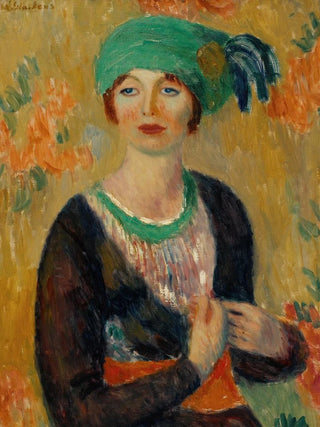Art print | Girl with Green Turban - William James Glackens


View from behind

Frame (optional)
Art print Fille au turban vert - William James Glackens – Engaging Introduction
In the expansive panorama of early 20th-century American art, William James Glackens' "Fille au turban vert" stands out for its vibrancy and boldness. Capturing a moment of intimacy and reflection, this painting evokes an atmosphere that is both serene and lively. The central figure, a young woman wearing a bright green turban, draws the eye and invites deep contemplation. The rich, nuanced color palette, along with the way light caresses the forms, creates a sense of immediacy, as if one could almost hear the whisper of her inner world.
Style and uniqueness of the work
Glackens' style, often associated with the Impressionist movement, is expressed here through daring use of colors and loose brushstrokes. "Fille au turban vert" reveals a technical mastery that transcends mere representation. The vibrant hues of the turban and the delicate shadows highlighting the young woman's facial features demonstrate a sensitivity to light and color. The artist manages to capture not only the physical appearance of his model but also an emotional essence, a fleeting moment of personal reflection. This work is a perfect example of Glackens' ability to merge the everyday with the extraordinary, transforming a banal moment into a scene of striking beauty.
The artist and his influence
William James Glackens, a prominent figure in American art, played a crucial role in the evolution of Impressionism in the United States. As a member of the Eight group, he sought to depict modern life with an innovative and personal approach. His influence is evident in the work of other contemporary artists, inspired by his ability to capture the essence of urban life while maintaining poetic sensitivity. Glackens was also a passionate advocate for art as a means of expression, aiming to break conventions and pave the way for new forms of interpretation. Through "Fille au turban vert," he invites us to appreciate the beauty of simple moments, to look beyond appearances, and to feel the depth of

Matte finish

View from behind

Frame (optional)
Art print Fille au turban vert - William James Glackens – Engaging Introduction
In the expansive panorama of early 20th-century American art, William James Glackens' "Fille au turban vert" stands out for its vibrancy and boldness. Capturing a moment of intimacy and reflection, this painting evokes an atmosphere that is both serene and lively. The central figure, a young woman wearing a bright green turban, draws the eye and invites deep contemplation. The rich, nuanced color palette, along with the way light caresses the forms, creates a sense of immediacy, as if one could almost hear the whisper of her inner world.
Style and uniqueness of the work
Glackens' style, often associated with the Impressionist movement, is expressed here through daring use of colors and loose brushstrokes. "Fille au turban vert" reveals a technical mastery that transcends mere representation. The vibrant hues of the turban and the delicate shadows highlighting the young woman's facial features demonstrate a sensitivity to light and color. The artist manages to capture not only the physical appearance of his model but also an emotional essence, a fleeting moment of personal reflection. This work is a perfect example of Glackens' ability to merge the everyday with the extraordinary, transforming a banal moment into a scene of striking beauty.
The artist and his influence
William James Glackens, a prominent figure in American art, played a crucial role in the evolution of Impressionism in the United States. As a member of the Eight group, he sought to depict modern life with an innovative and personal approach. His influence is evident in the work of other contemporary artists, inspired by his ability to capture the essence of urban life while maintaining poetic sensitivity. Glackens was also a passionate advocate for art as a means of expression, aiming to break conventions and pave the way for new forms of interpretation. Through "Fille au turban vert," he invites us to appreciate the beauty of simple moments, to look beyond appearances, and to feel the depth of






